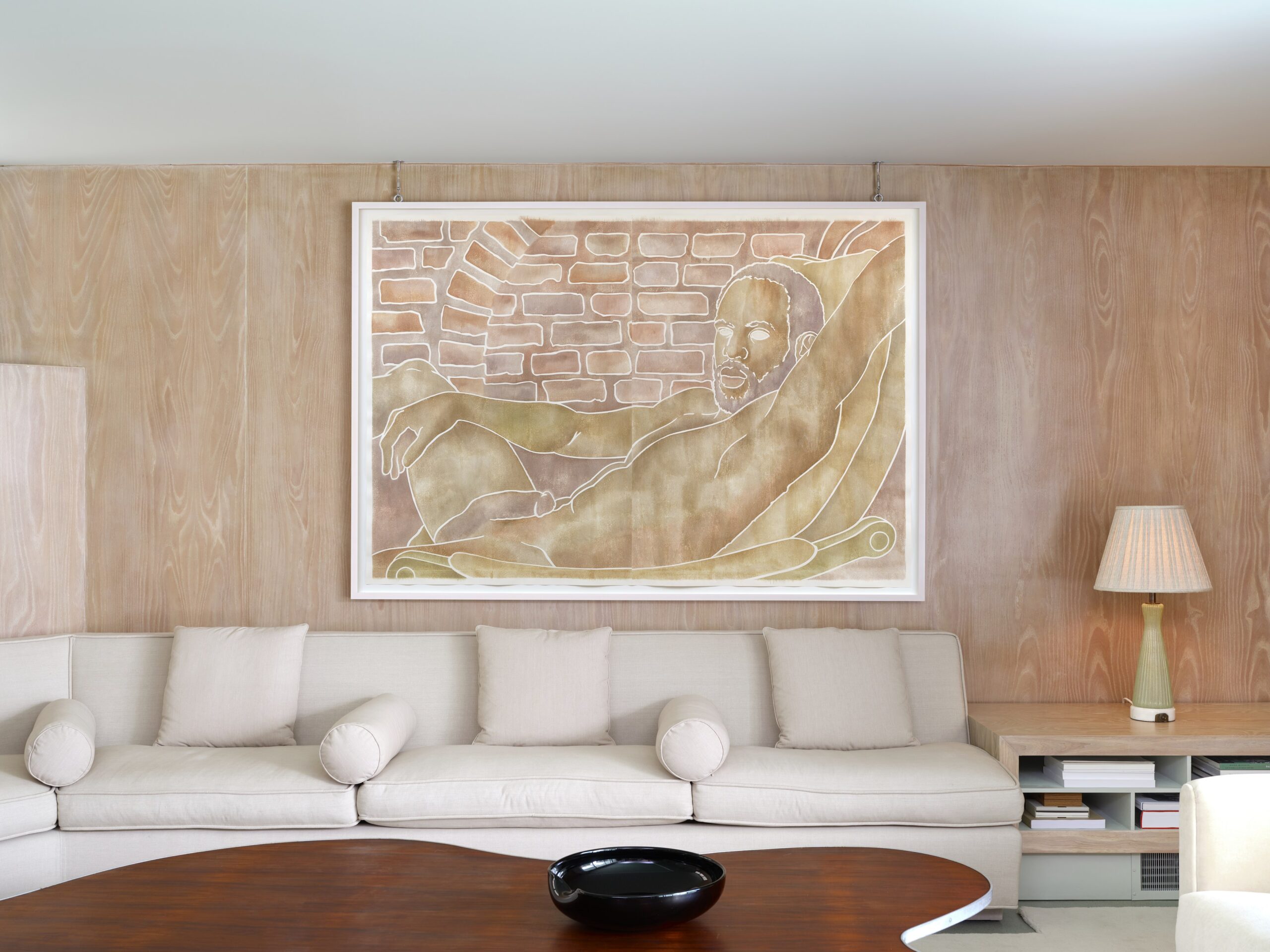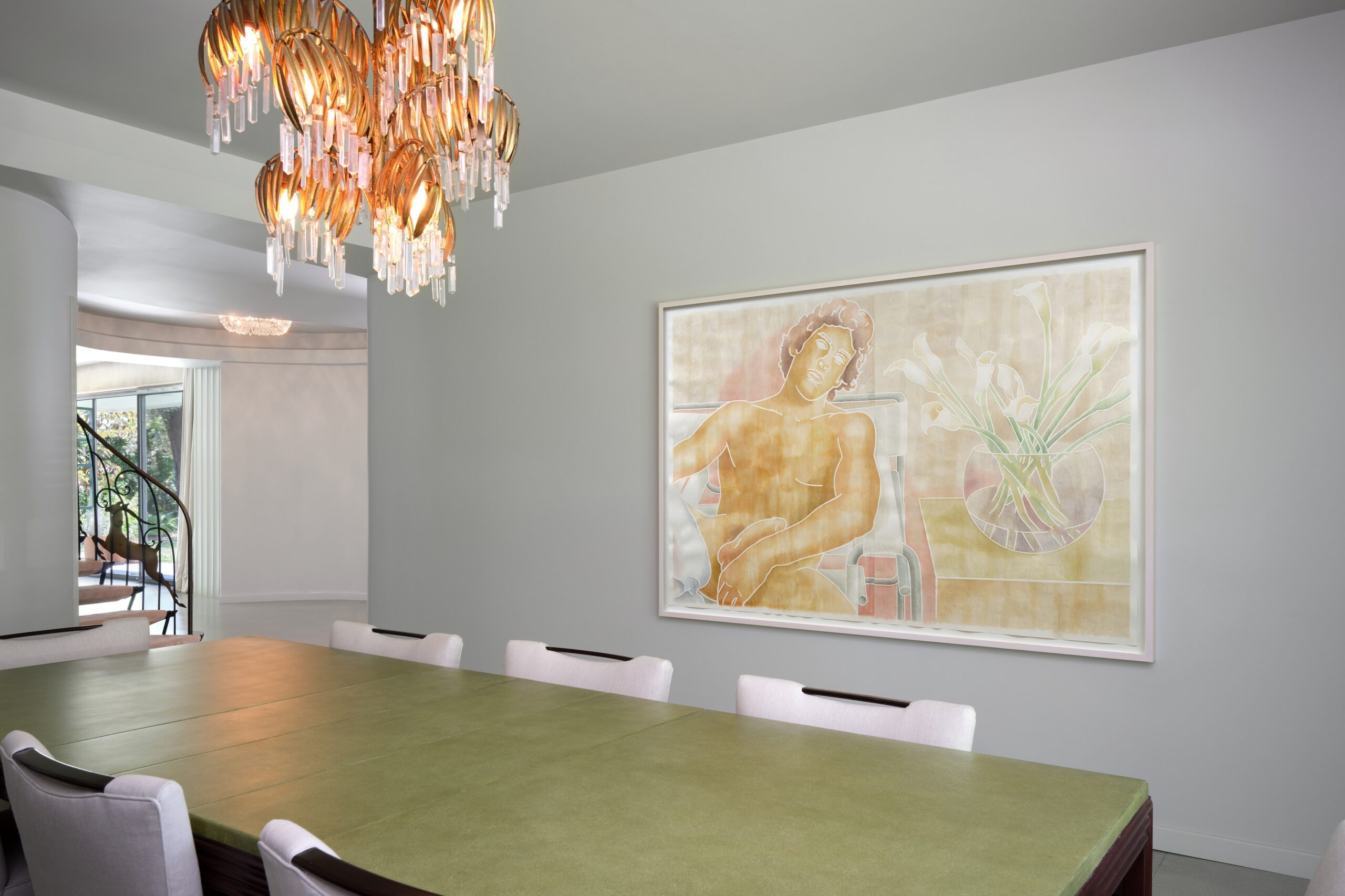
Monica Majoli, Playguy (Ben), 2023, watercolor woodcut transfer on paper, 54 1⁄2 × 78 3⁄8″ ioff-site at the 1952 home designed and owned by African American architect Paul R. Williams in the Mid City district of Los Angeles
When Vanity Fair published Gertrude Stein’s word portrait “Miss Furr and Miss Skeene” in 1923, the story ran with the subhead “The Tale of Two Young Ladies Who Were Gay Together and of How One Left the Other Behind.” This, an editor’s reframing of Stein’s modernist style for the expediency of narrative clarity, misses what is pleasurable about the author’s text in the first place, specifically, how she coyly subverts and mutates language. Here’s a snippet to give one an idea:
They were quite gay, they were quite regular, they were learning little things, gay little things, they were gay inside them the same amount they had been gay, they were gay the same length of time they had been gay every day.
The two gay Mses. of Stein’s staccato word vortex were in fact based on a very real couple: Maud Hunt Squire and Ethel Mars, artists and children’s book illustrators. Together, Squire/Skeene and Mars/Furr helped to forge a novel printmaking technique—the white-line woodcut—while living in Provincetown, Massachusetts, among other artists practicing the form. The method involves carving only the lines of the image instead of the negative spaces around them, as one does with (ahem) a “normal” woodcut. This, in essence, streamlines the process, and allows a printmaker to treat the uncarved sections of the block in less delimited ways, resulting in works that can look and function more like monoprints.

Monica Majoli, Blueboy (Tom), 2023, watercolor woodcut transfer on paper, 54 1⁄2 × 78 3⁄8″ ioff-site at the 1952 home designed and owned by African American architect Paul R. Williams in the Mid City district of Los Angeles
Monica Majoli’s recent exhibition with Hannah Hoffman was located off-site at the 1952 home designed and owned by African American architect Paul R. Williams in the Mid City district of Los Angeles. After the Supreme Court abolished racial covenants across the US in 1948, the neighborhood became integrated. In this sleek modernist edifice, Majoli showed a trio of new pieces from her white-line print series “Blueboys,” 2015–, which takes its title from Blueboy, a liberation-era gay-porn glossy published between 1974 and 2007. Suiting the works to the context of Williams’s home—which was recently restored by Hoffman, its new owner—the artist rightly scaled up the images to a massive degree (the tallest one was six feet high, while the longest was more than six and a half feet) and displayed them across three different ground-floor rooms. Each one was eccentrically hung and interpellated self-consciously with and against the decor and history of the home.
Blueboy (Rameses) (all works 2023) presents the titular model in a caftan—the garment reinforcing the orientalizing eroticism of his porn alias. But Majoli’s palette is a thoughtful counterpoint to the seedy pulpiness that usually saturates such loaded imagery, as she elected for a more restrained range of light, camo-style taupes and greens to build her composition. The subtle tonal shifts of the artist’s colors indicated the stylized body’s dimensionality—the underside of a thigh, a vertical patch of chest. Suspended from eye bolts and cables screwed into the ceiling, the work appeared as if it were floating in front of a floor-to-ceiling curtained glass wall.
In the following room, Playguy (Ben) was nestled into a beautiful wooden alcove—a muscular thing, like the work’s subject—that elegantly defines a living-room seating area. And Blueboy (Tom) was placed in the dining room, an airy space overlooking a well-manicured lawn and street—a thoroughfare that, incedentally, Williams integrated by being one of its first Black residents. Majoli’s men populated a house designed and suited to his tastes, which have their own endearing charms, such as the fleet of gazelles that leap up a curved staircase banister, or the hexagonal baffled coffers on the ceiling. Conjuring the lives and passions of globe-trotting lesbians, gay (or gay-for-pay) porn models, and a straight architect who left a profound aesthetic mark on the city, Majoli’s installation left a plethora of “little things” for the viewer to puzzle out and savor.